Rishad Tobaccowala's Blog
November 30, 2025
Time to ChatGPT/Gemini/Claude/Grok Oneself.

Midjourney to prompt “mirror with Open AI, Grok, Gemini and Claude logos”
A three step exercise that may be eye opening.
Repeat with all four engines (ideally with the paid versions to understand potential.)
Step One: Select your AI engine or engines.Enter your name and ask it to write your obituary.
Upload as many appraisals or evaluations you have received. Ask for an analysis.
Ask why you are worth hiring or not worth hiring.
Interrogate each of these answers by asking for supporting evidence or question the analysis. Change tone of voice from appreciative to shocked. If it is a multi-modal engine ask for a visual to depict the answer. Ask it to write a slogan or a song.
These steps will make us realize how much the Alien Intelligence (my term for AI) already knows about everyone. This versus Search or LinkedIn is how people will begin analyzing others and companies evaluating talent.
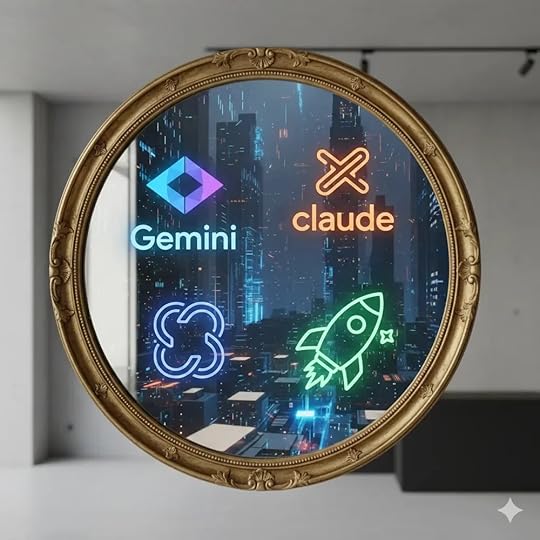
Gemini Nano Banana to prompt “mirror with Open AI, Grok, Gemini and Claude logos”
Step Two: Ask other humans these questions. Then ask yourself. Then AI.Three people outside of their immediate family that have been most impactful in their life positively? And negatively?
Three most transformational experiences (good or bad) that have shaped them?
If they had 10 years to live what would they change moving forward and why?
These really get true conversations going with others and oneself. These are conversations with intense meaning, deep feeling, and human emotion. Now check how these answers compare with that of the different AI engines.
Also note how you might keep asking more questions and follow ups with different tones of voice to the AI versus real humans or yourself. What do these longer and deeper conversations reveal about other people, the machine and ourselves.
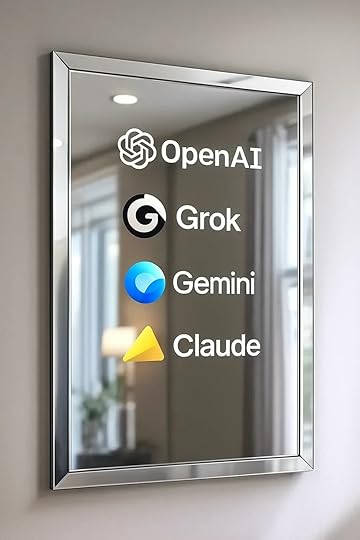
ChatGPT to prompt “mirror with Open AI, Grok, Gemini and Claude logos”
Step Three : Ask your manager these questions. Then ask yourself. Then ask AI.How much of my job will be done by an Agent 2 years from now and what will happen to me?
Do they worry if they themselves will become irrelevant soon?
How would they attack their own company to defeat it?
These remind us that every company, every job and every career will be dramatically changed in less then 500 days and we all need to reinvent fast.
It also reveals how much company data has already been uploaded by employees or others into the public domain. Very little is secret.
For these answers pretend the AI is BCG, or Mckinsey or Bain and ask it to provide recommendations, analysis and action steps. This is why Mckinsey already has 12,000 agents to its 40,000 humans and is expects the ratio to be 1 to 1…
Try these exercises as a way to embrace AI, adapt your career/life and identify where one can complement the machine.
November 23, 2025
Companies Do Not Transform. PeopleDo.

Visual via Midjourney
Organizations everywhere are struggling with change and seeking new ways to grow especially in these Tectonic Times .
Many specialists help them find a way forward.
A cavalcade of consultants, convey and communicate with countless charts, a curated combination of choices to the C-Suite.
A flurry of futurists frame, focus, and filter the way forward with the finesse of fortune tellers.
Masters of the Universe market M&A moves that might make multiples move upwards and manufacture many millions in market-cap.
PR professionals produce and promote points of view that position and polish to provoke the press to perceive with pristine perspectives.
While all of this may be important none of these will work without growing and changing the people in the organization.
While firms are a collection of ideas, technologies, patents, brands, ecosystems and people, it is people who are the the key. Because it is the people who create the ideas, technologies, patents, brands and eco-systems!
And in today’s AI age the technology itself is not a differentiator since everyone builds on the same half a dozen foundational models. It is the Humans who combines with the Alien Intelligence ( a better description of AI) that produce the distinctiveness and differentiation which drives value creation.
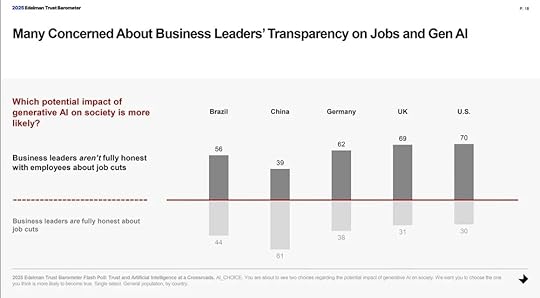 1. People and Organization the real challenge.
1. People and Organization the real challenge.Michael Tyson said, “Everyone has a plan till they get punched in the face”.
Boards and leadership of firms come quickly to the realization that everything is easy until people get in the way.
Today, all over the world is there is deep concern among people in many organizations that AI is a threat to their livelihoods. Richard Edelman earlier this week at a dinner that Terence Kawaja invited us to after the announcement of the AI Lumascape (take a look it has created quite a stir) handed me the latest Edelman’s Trust Barometer flash poll which is worth reading. Here is the link to the report and one of the slides is reprinted above.
Whether it is Accenture, Bain, BCG, Deloitte or McKinsey, they all appear to be aligned that AI transformation will primarily be about people and organizations and not technology. Here is a great piece on Julie Sweet the CEO of Accenture on the need for reinvented leadership.
Telling people that change is good, threatening them with job loss if they do not change or creating communication materials and slogans to goad them into a cult like devotion to the new dear leader or the way forward rarely works in the short run and will likely fail after the threat of flagellation fades.
Too many companies are focussing on efficiency, effectiveness and enterprise technology versus talent.
Because, if there is nothing in it for them, people will out-wit, out-wait, out-pretend, and out-maneuver “management”. Until then they will fill the time genuflecting and bowing and going through the monitored motions of attending the right meetings, muttering the motivational mantras and stating the slogans required.
Today 67 percent of GenZ employees have a side gig with which they generate income, using the salary from their “main job” to create new options for themselves. After all , for 60 dollars a month anybody at any level, can have the latest Google, Open AI and Anthropic tools that run circles around what they are allowed to use at work. These tools provide all of us with cost effective and fast ways to launch AI first businesses with talent of any type (Agentic employees galore) and humans distributed anywhere in the world.
If we want our organization or our teams to grow and change we will need to deliver answers to four questions to our teams:
Why are the recommended changes good for them?
How can it help them grow ?
What are the monetary or other incentives to change?
When and where will training be provided to help them learn the new skills needed?
Change does not happen because of M&A, press Releases, re-organizations, or announcing an Open AI or some other AI partnership.
An organization changes and grows when the people in the organization change and grow.
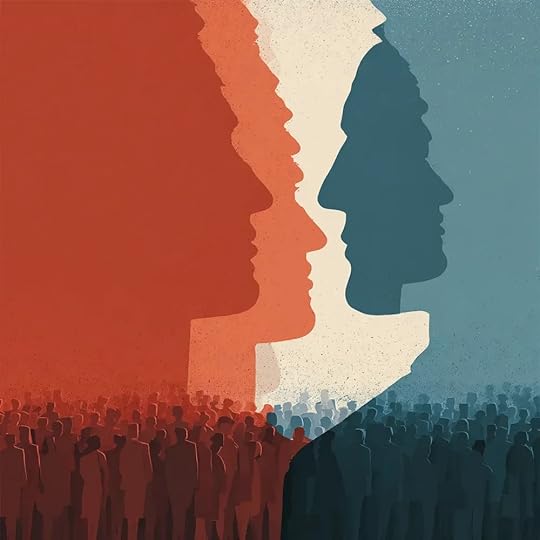
Visual via Midjourney
2. There are two ways to change an organization: Get people to change or change the people.What are the key ingredients that helped drive the successful transformation of companies including very large ones like Walmart and Microsoft?
Both firms had “lifers” take over as the CEO after years of each company roaming in the wilderness. They both succeeded in rejuvenating their firms by combining two different approaches:
A) Upgrading the mindset of a majority of the people at the firm.
This is best seen by the changes Satya Nadella has made at Microsoft which including moving from a “know it all mindset” to a “growth mindset”, a focus on enterprise and business professionals, a shift to openness and cloud and the elimination of the Windows Operating division. He also engineered a move away from a prickly approach of a “We vs the World” mindset to the embrace of the everything in the world including Linux with the purchase of GitHub to the Open AI investment and the hiring of Mustafa Suleyman from Google.
Through it all the focus has been on new behaviors and mindsets of people including top level and key talent.
B) A recruitment of key outsiders and high-level leaders and an investment in new people and skills.
This can be seen at Walmart. Doug McMillon who just announced his retirement, completely re-imagined the company through a combination of bringing in outsiders with acquisitions such as Jet, Flipkart, Vizio and most recently Dan Danker from Instacart to lead AI initiatives and launching highly profitable new lines of business such as Walmart Connect. But a major emphasis was als made in investing in current employees with better pay and job flexibility combined with a significant number of initiatives to up-skill employees including a one billion dollar investment in Walmart Academy.
Central to changes at both these companies ( whose market value have increased four fold (Walmart) and ten fold (Microsoft) in a decade under these leaders ) are that they combine revitalized/new leadership, a re-defined strategy and or organization with an emphasis on investing in growing and helping as many employees as possible transform themselves.
A new strategy, a new leader and a new organization are often necessary, but they are never sufficient to regain growth and manage change. To achieve this aim it is critical that the rank and file needs to be communicated with, incentivized and trained to change and grow.
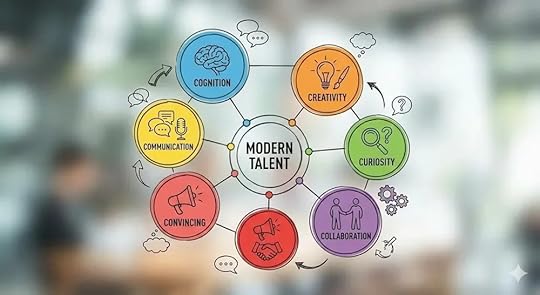
Visual via Gemini Nano Banana Pro
3. The Six C’s Required of Modern Talent.Today like never before we are living in a world of rapid transformation and change.
New industries rise and fall and the inter-connected unstoppable forces of globalization, demographic change and technology twist and toss all of us.
In this landscape how do we train talent or hone our own skills?
What will remain relevant and in demand in an age of shorter and shorter half-lives of firms and business models?
Six key skills will be essential in the future. Three of these have to do with the individual (Cognition, Creativity, Curiosity) and three on how we connect with each other and the world outside our minds including working with Agentic employees and AI Tools (Collaborate, Communicate, Convince).
Cognition is simply learning to think and keeping our mental operating system constantly upgraded. This requires deliberate practice and sustained work. Improved cognition is achievable.
Creativity is connecting dots in new ways, looking beyond the obvious and this skill will be key as AI powered computers, data crunch and co-relate faster than we ever will. To be human is to be creative. Creativity as vividly described by Sir John Hegarty is “an expression of oneself”.
Curiosity is simply being alive to possibilities, questioning the status quo and asking two questions. What If ? And Why Not ? Today the key competitor or opportunity in any category comes from outside it. Curiosity may have killed the cat, but the lack of curiosity may kill the the careers of many people.
Being cognitively gifted, creative and curious will not be enough since we are living in a connected world where eco-systems, teams and linkages are how ideas are born, value created, and long-term careers forged. It is a world where we will need to combine with five types of employees in a firm ( Full-time, Free-lance, Contract, Fractionalized and Agentic). To do so we will need to hone, build and train for three other skills:
Collaborate: Collaboration is key to work in a world where API’s (Application Protocol Interfaces) and MCP’s (Machine Context Protocols) are not just about handshakes or conversations between technology but also between individuals with different skills, teams in different countries, partners, suppliers and much more.
Communicate: Learn to write. Learn to speak. Learn to present. It may be so old school but watch the people who succeed, and they are good at communication. And all of these can be taught and learned.
Convince: Every one of us is a salesperson regardless of what we believe our title is. This is true even if we do not sell anything at work. We have to convince colleagues of our points of view. We have to convince our partners to join us on our life journey. Learn to convince and learn to sell. Story telling is a key.

Visual via Grok by xAI
4. The Four Keys to Evaluating Experienced Hires Before Letting Them In.It is rare that a company can avoid hiring significant talent from outside if it is serious about transforming itself to change and grow. New skills, new mindsets and new blood enhances the corporate genetic pool.
But these hires are particularly fraught, and experience indicates that focusing on four key criteria can minimize the risk.
These are a) Mental Agility, b) Integrity, c) Impact and d) Fit/Chemistry.
Two of these filters Mental Agility and Fit/Chemistry require multiple interviews and two of them —Impact and Integrity —require deep investigation (background checks, references).
Mental agility is key to lead a team or a company in a world of change and only in an interview can one test for this. Similarly, chemistry matters. Too many companies bring in a wunderkind who either fails to adapt or is chewed up and spit out by the organization. While “Culture” may eat strategy for breakfast it hones its chewing skills by gnawing on the bones of outside talent.
Integrity and Impact needs to be evaluated over time and requires in depth research.
Integrity has never been more important and in today’s world trust is increasingly key.
Impact on Business can be measured through financial results but as important is how the individual has built teams, grown people and dealt with long term periods of stress or setback.
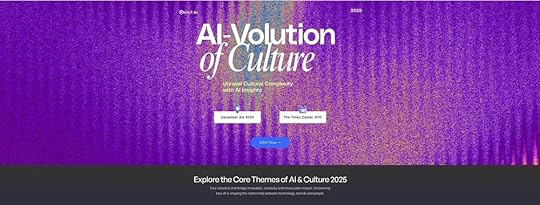
Ex-bosses and ex-direct reports are usually the ideal people to interrogate since they can provide perspective, put things into context and provide a multi-faceted picture of the person and are far less constrained than current colleagues or suppliers.
AI-Volution of Culture on December 3 at the New York Times Center.
Interested in gaining some insights, ideas and much more about how culture and people are transforming? I have comp tickets. As some of you know, I sit on the board of Quilt.AI. Many years ago, one of the co-founders fed me a $4 breakfast at a hawker center in Singapore and now they have graduated to hosting AI & Culture events in New York City. Amazing speakers in a short 4 hour action packed afternoon including Nick Thompson, editor of the Atlantic, Georgina Scholtens, CMO of Versace, and Dr. Patrick Leddin, best selling author. If you are NYC based, please join as my guest by registering for free on this link: Rishad’s Guest Link.
November 16, 2025
Better.

Despite the algorithmic armies, and agentic AI’s, everyone has agency.
Nothing is written. Nothing pre-determined. There is no “way” or some force to align with.
Chances we take. Choices we make. Changes we adapt to.
Taking a risk when given a chance. Making the right choices. Accepting change.
All up to each of us.
Three ways to become better:
1.Do the next best thing.
2. Leave things better.
3. Better our previous self.
Do the next best thing.Our lives are a sum of our choices.
Often we face a choice.
At other time we force a choice.
To stay or to go. To help or turn away. To scroll or to read. To do this or do that.
Sometimes there is more than one choice.
Regardless of what has happened before, despite what we wish we had done or might have said in the past, what is the best next thing can we do now with everything we currently know?
That is the choice to make.
The best thing among the choices one has available, rather than agonizing over mistakes made, or choices no longer available, or that were never available.
Leave things better.How can we leave things better?
This might be a person, a place, a task or ourselves.
At the end of every interaction how can we leave people with a sense of clarity, or belief in themselves or a renewed sense of energy?
When we leave a place can we do so in a way that our presence left it improved or enhanced?
Can we bring our craft, skill, expertise and caring to a task or a job to do it better?
Leaving people better, a place upgraded or doing a task with excellence often makes one feel better.
When we get out of our minds and ourselves and focus on others we grow.
Better our previous self.Benchmarking against others is a good way to set standards and goals, but getting better is constant improvement versus our previous selves.
A compounding day after day that yields a better self.
Compare not to others but to oneself.
What can we do to get better today versus yesterday?
Improvement is a sum of small atomic sized habits or moves.
One more of this. One less of that.
One more of this and one more of that every day adds to one getting better.
In the end our satisfaction, contentment and happiness are a result of what we do, how we take responsibility, the decisions we stand by, and how we help others.
The next best thing. Leave things better. Better than our previous self.
November 9, 2025
Upgrading Our Mental Operating Systems.
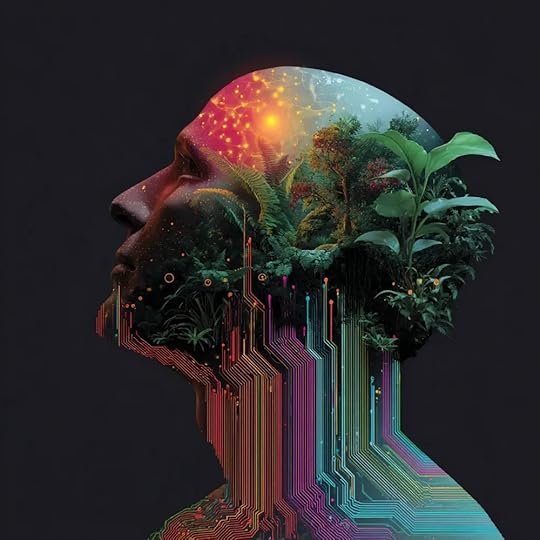
Image by Midjourney to prompt: Upgrading our mental operating system.
In our pockets we all carry a device that has upgraded its mind 16 (Android OS) or 18 times (Apple iOS) in the past 18 years.
These same mobile devices contain applications from Open AI, or Google, or Anthropic, or xAI or some other frontier models which are improving themselves constantly and doubling their capability every few months.
How many times have we upgraded our own mental operating systems in the past 18 years?
If the future does not fit in the containers of the past then it also does not fit in the mindsets of the past.
Successful people and successful companies rarely get defeated by others.
Rather, they sometimes defeat themselves because they fail to change their frameworks, worldviews, mindsets and approaches as the world changes around them.
Their strategies go stale.
A definition of strategy is “future competitive advantage”.
Thus any company or leader working to a strategy that is more than five years old should revisit the assumptions they made years ago about the future. In a world of AI, Generational Ruptures, New Globalization and technology has empowered consumers and customers with “God-Like Power”, many firms may may be operating on an irrelevant picture of the future.
The future does not bend to us. We have to bend to the future.
We have to upgrade ourselves to remain relevant and not just be up to date but up to tomorrow.
As someone who began his career building the case for cable television four decades ago when the US had just 3 networks, to launching the first digital services over 25 years ago, to now advising Boards on AI and the Future of Work, I have come to learn the importance of constant upgrading to remain relevant.
My first book, Restoring the Soul of Business: Staying Human in an Age of Data continues to sell well nearly six years after publication because the content was written to be evergreen but also because it was prescient about the issues we face today with most people believing the subtitle reads “Staying Human in an Age of AI”.
One of the three most popular chapters in the book along with “ The Turd on the Table” and “ Change Sucks”, is “Upgrade Your Mental Operating System”.
In “Upgrade Your Mental Operating System” I share everything I have learned over decades of practice and observation on how each of us and our companies can remain relevant.
Today the entire chapter is accessible and downloadable for free :
UPGRADING YOUR MENTAL OPERATING SYSTEM ∙ DOWNLOAD ∙ 417KB ∙ PDF fileThe 3 step process to upgrading one’s mental operating system is:
Spend an hour a day learning : If we do not invest time for learning we will become irrelevant. No if’s or but’s about it. The future belongs to leaders who are always learning vs those who are believe they are all knowing.
Build a case for the opposite of what we believe is true: New technologies are challenging some assumptions of the past such as scale is a benefit. In an AI age scale may matter less in an increasing number of categories. Another reason to build a case for the opposite case is to compensate for our tendency to surround ourselves with people who agree with us or to look for confirming data. To exercise our minds and identify our vulnerabilities we should attack our own thinking once in a while.
Focus time on making versus managing : We need to build, sell, create, mentor and guide a majority of the time we are at work versus checking in, monitoring, measuring and attending meetings. Increasingly, building knowledge bases, processing and data collection, manipulating of charts, summarizing and laying out options, are all going to be done by machines. The key is to build our HI where HI is not just Human Intelligence but also Human Insight, Human Interaction, Human Inventiveness, Human Imagination, Human Intuition and Human Inspiration.
If I were to update this chapter six years later, I would add a section on Remaining Relevant in an AI age by incorporating the piece which is linked to below:
It details :
a) How we should embrace, adapt and complement AI.
b) The Six key skills of Cognition, Curiosity, Creativity, Collaboration, Convincing and Communication we need to hone.
c) The importance of developing a sense of self, a singular voice and a personal taste.
Here is the piece :
Remaining Relevant in an AI Age. by Rishad Tobaccowala
The Future Does Not Fit in the Containers of the Past. Edition 151.
Read on SubstackThe future is bright.
All we have to do is upgrade ourselves to continue to thrive.
...

Image by Midjourney to prompt: Upgrading our mental operating system.
In our pockets we all carry a device that has upgraded its mind 16 (Android OS) or 18 times (Apple iOS) in the past 18 years.
These same mobile devices contain applications from Open AI, or Google, or Anthropic, or xAI or some other frontier models which are improving themselves constantly and doubling their capability every few months.
How many times have we upgraded our own mental operating systems in the past 18 years?
If the future does not fit in the containers of the past then it also does not fit in the mindsets of the past.
Successful people and successful companies rarely get defeated by others.
Rather, they sometimes defeat themselves because they fail to change their frameworks, worldviews, mindsets and approaches as the world changes around them.
Their strategies go stale.
A definition of strategy is “future competitive advantage”.
Thus any company or leader working to a strategy that is more than five years old should revisit the assumptions they made years ago about the future. In a world of AI, Generational Ruptures, New Globalization and technology has empowered consumers and customers with “God-Like Power”, many firms may may be operating on an irrelevant picture of the future.
The future does not bend to us. We have to bend to the future.
We have to upgrade ourselves to remain relevant and not just be up to date but up to tomorrow.
As someone who began his career building the case for cable television four decades ago when the US had just 3 networks, to launching the first digital services over 25 years ago, to now advising Boards on AI and the Future of Work, I have come to learn the importance of constant upgrading to remain relevant.
My first book, Restoring the Soul of Business: Staying Human in an Age of Data continues to sell well nearly six years after publication because the content was written to be evergreen but also because it was prescient about the issues we face today with most people believing the subtitle reads “Staying Human in an Age of AI”.
One of the three most popular chapters in the book along with “ The Turd on the Table” and “ Change Sucks”, is “Upgrade Your Mental Operating System”.
In “Upgrade Your Mental Operating System” I share everything I have learned over decades of practice and observation on how each of us and our companies can remain relevant.
Today the entire chapter is accessible and downloadable for free :
UPGRADING YOUR MENTAL OPERATING SYSTEM ∙ DOWNLOAD ∙ 417KB ∙ PDF fileThe 3 step process to upgrading one’s mental operating system is:
Spend an hour a day learning : If we do not invest time for learning we will become irrelevant. No if’s or but’s about it. The future belongs to leaders who are always learning vs those who are believe they are all knowing.
Build a case for the opposite of what we believe is true: New technologies are challenging some assumptions of the past such as scale is a benefit. In an AI age scale may matter less in an increasing number of categories. Another reason to build a case for the opposite case is to compensate for our tendency to surround ourselves with people who agree with us or to look for confirming data. To exercise our minds and identify our vulnerabilities we should attack our own thinking once in a while.
Focus time on making versus managing : We need to build, sell, create, mentor and guide a majority of the time we are at work versus checking in, monitoring, measuring and attending meetings. Increasingly, building knowledge bases, processing and data collection, manipulating of charts, summarizing and laying out options, are all going to be done by machines. The key is to build our HI where HI is not just Human Intelligence but also Human Insight, Human Interaction, Human Inventiveness, Human Imagination, Human Intuition and Human Inspiration.
If I were to update this chapter six years later, I would add a section on Remaining Relevant in an AI age by incorporating the piece which is linked to below:
It details :
a) How we should embrace, adapt and complement AI.
b) The Six key skills of Cognition, Curiosity, Creativity, Collaboration, Convincing and Communication we need to hone.
c) The importance of developing a sense of self, a singular voice and a personal taste.
Here is the piece :
Remaining Relevant in an AI Age. by Rishad Tobaccowala
The Future Does Not Fit in the Containers of the Past. Edition 151.
Read on SubstackThe future is bright.
All we have to do is upgrade ourselves to continue to thrive.
November 2, 2025
Humanity, Meaning and Work in an Agentic Age.

Mid Journey response to the prompt..humanity, meaning and work in an agentic age.
From the WSJ
“AI is now a topic of conversation at every meeting of McKinsey’s board, said Bob Sternfels, the firm’s global managing partner. The technology is changing the ways McKinsey works with clients, how it hires and even what projects it takes on.
And McKinsey is rapidly deploying thousands of AI agents. Those bots now assist consultants in building PowerPoint decks, taking notes and summing up interviews and research documents for clients. The most-used bot is one that helps employees write in a classic “McKinsey tone of voice”—language the firm describes as sharp, concise and clear. Another popular agent checks the logic of a consultant’s arguments, verifying the flow of reasoning makes sense.
Sternfels said he sees a day in the not-too-distant future when McKinsey has one AI agent for every human it employs.
“We’re going to continue to hire, but we’re also going to continue to build agents,” he said.
Already, the shape of the company is shifting. The firm has reduced its head count from about 45,000 people in 2023 to 40,000 through layoffs and attrition, in part to correct for an aggressive pandemic hiring spree. It has since also rolled out roughly 12,000 AI agents.”
And from CNBC
“This week, Amazon announced it had begun a reorganization that would result in the elimination of 14,000 roles — and said AI was a leading cause.
“The world is changing quickly,” Amazon Senior Vice President Beth Galetti wrote Tuesday. “This generation of AI is the most transformative technology we’ve seen since the Internet, and it’s enabling companies to innovate much faster than ever before.”
Walmart recently signaled that it intends to keep headcount flat over the next several years, largely as a result of AI.
Goldman Sachs announced a fresh round of layoffs this month, saying it planned to reduce human roles that AI could potentially perform.
Salesforce recently reduced its workforce by 4,000, citing “the benefits and efficiencies” of AI.
These are highly-profitable, fast-growing, world-class, expertly-led firms.
There is a great debate on whether these layoffs are due to AI, or over-hiring, or flattening of organizations, but there is no doubt that most companies have swiveled from vanity metrics of number of employees to a new key metric which is revenue per employee. And in most companies employees who leave are often not replaced by other employees but rather their jobs are eliminated or substituted by an AI Agent. “
This according to CNBC despite some misgivings as to whether AI is actually delivering ROI:
“Out of 1,250 firms surveyed by Boston Consulting Group for a September report, 60% said they had seen “minimal revenue and cost gains despite substantial investment” in AI.
Only 10% of the organizations involved in a similar Deloitte survey said they were getting “significant return on investment from agentic AI,” or systems that can make decisions beyond simply following prompts”
What happens when our jobs get replaced by agents or we soon find ourselves with more agentic co-workers than human co-workers? What happens when our incomes get reduced or eliminated or let us say we get some sort of basic universal income and told to stay at home ( a hysterically delusional rant when the current system struggles to fund basic health care to millions who are employed!)
Over the past few weeks I have spoken with dozens of leaders and experts around the world in various areas including AI and in all this noise there are some clear signals though exactly how all of this will play out is anybody’s guess. Things are too fluid, moving too fast and too early for anyone to say they really know how things will unfold, but there seems to be some broad agreement that it is likely that:
a) We may have passed peak jobs as jobs and work gets uncoupled. There may be more opportunities for work but fewer full time jobs.
b) Most companies are struggling to move from a “job/experience focussed” mindset to a “work to be done/expertise approach.”
c) HR and Talent departments will be critical to transformation because most of the challenges are organizational and human and not about technology.
d) Still too many companies are using AI like they might use electricity to make candles more efficiently and effectively, versus realizing that like the advent of electricity the very work of the firm, the organization and the competitive set are all going to be dramatically different. Stop making candles since there will soon be no need for them in an age of electricity. This is a change of the system problem versus making the existing system more efficient problem .
e) A generational shift in expectations and mindsets is causing a rupture between what the senior managers and Board of a company believe and what the next generation of talent believes, expects, sees and experiences. This shift is being accelerated by AI which is reducing the value of knowledge and experience but raising the value of learning and unlearning.
f) Unsaid but not far from peoples’ minds are questions of meaning, purpose and role of humans and our own future. Many people are wondering whether they are building and training the wood chip machine that they will be put into. Most are realizing that we need to upgrade our skills, build our networks, manage our balance sheet so we have options and not depend on our company. We are headcount in a highly competitive client focussed profit maximizing enterprise and not members of a “family.”
Four conversations that prepare us for whatever might come.
Whether you are graduating from school or in the final decade of your career, whether you are self-employed person or the CEO of a multi-billion dollar company, whether you are parent or not, whether you understand and care about technology or not, one way to prepare for the future is to learn from from four conversations filled with usable insights and ideas.
My guests were in Chicago, London, Dubai and Cape Town South Africa. They are a distinguished engineer, a best selling strategist, a mother of GenZ kids and a 25 year old. Wide spectrum thinking with specific next steps, tactics and approaches that give you actionable inspiration for the coming wild and potentially wonderful age…
They are all free to listen to and free of any advertising or promotion. Just a gift…( the links below are for Apple podcast but you can find them on Spotify and YouTube)
Conversation 1: Humanity, Humans and Meaning in the Agentic Workplace.
Omar Imtiaz, Distinguished Enterprise Architect at Salesforce on the transformative impact of AI on human work. With a background of decades in computer science and IT, Omar argues the importance of the shift from technology-driven to human-centered transformation with AI enhancing human capabilities rather than replacing them. Advocating for a collaborative approach where AI and humans work together, he reminds us that meaning, purpose and emotional engagement is the future of the workplace, unleashing a completely new generation of creativity.
But Omar clarifies why this will be difficult and some of the real challenges humans and firms will face. Our conversation touches on “Move 37” , on being “speciest”, why with agentic capabilities companies will not need different specialized departments, and how Salesforce and its Agents jousted with each other…
Omar joins us in his personal capacity. The opinions shared are his own and do not necessarily reflect those of Salesforce. Nothing here is confidential, proprietary, or advice; it’s a general discussion of industry topics.
Conversation 2: How is AI reshaping who holds power in the knowledge economy?
Sangeet Paul Choudary, the best-selling author of Platform Revolution and Reshuffle explains how artificial intelligence is re-stacking the way knowledge is created, distributed, and monetized, and what this means for workers, companies, and the future of competitive advantage.
Just listen to him explain how AI is like the Container Ship and you will see and understand more about AI in 10 minutes that you might have before. We discuss why individuals need to and can do to stay above the algorithm. Why despite all the technology that can replace them, Radiologists and Sommeliers continue to thrive and how we can all future proof our careers by learning from them.
His book Reshuffle is the one I am recommending to every Board and leader and once they read it they often ask to speak to Sangeet. Take a listen and you will in 40 minutes be better qualified on strategy and career thriving in an AI Age than most people who keynote at conferences on these topics…
Conversation 3: Alex McCann on the The Death of the Corporate Job.
Alex McCann is a writer, community builder, and founder of TrueNorth, an AI-powered career coach designed to help people build meaningful careers by starting with self-discovery, not job titlesWhat if the corporate job is no longer the default path to a meaningful career? Alex McCann, founder of TrueNorth, explains why so many young professionals feel lost at work, how Gen Z is redefining success, and why the future may belong to those who start with self-discovery instead of job titles.
Through TrueNorth, his MidWeek events in London, and his newsletter Still Wandering, Alex helps people in their 20s and 30s navigate uncertainty, question outdated career narratives, and define success on their own terms. His work is grounded in a simple belief: you can’t build a fulfilling career until you understand what meaning means to you. Alex now focuses on giving Gen Z and Millennials the tools, language, and community to design lives and work they can truly stand behind.
Conversation 4: Jillian Reilly on the courage to choose yourself.
Jillian Reilly is a founder, author of The Ten Permissions , mother of two GenZ boys and keynote speaker. Having spent her 30-year career working in social, organizational, and individual change across Africa, Asia, and Central Europe, Jillian’s focus is on helping people unlock their ability to navigate change and accelerate growth and learning. Jillian’s upcoming book, The Ten Permissions, guides readers in permitting themselves to update how they operate in the 21st century and design lives that fully leverage the possibilities of this disruptive world.
In our conversation one will learn why each of us need to unleash, unhook and unfurl ourselves from a system of expectations, measures and approval that holds us down. Jillian shows us what we need to leave behind to thrive in the world we are moving to. Change begins with each of us and Jillian shares what we need to do. Listen and you will come away different and see your obstacles disappear and learn to rethink your beliefs in a new light.
A range of free resources to prepare for next here: https://rethinking-work.io/
October 26, 2025
Looking Back: Five Learnings.

This past week I was fortunate to be honored at an event in NY. After acknowledging the other recipients who are in the prime of their careers ( very much like the 350 leaders in the audience) and thanking those who enabled my success, I shared five learnings that that have proved useful to finding success in work and life with the next generation.
1. Repair/Practice Resurrection.In any career and sometimes in a single year we will believe we have arrived at Good Friday. We feel that all is lost and our future potential has been crucified. But let us never forget to focus on Easter Sunday and raise ourselves up again.
To do so we need to practice repair.
“Everything that has a shape breaks”- Japanese Proverb
But…
“The world breaks everyone and afterward many are strong at the broken places”- Ernest Hemingway
And…
“Repair is the creative destruction of brokenness”—Elizabeth Spelman
Read more about how to repair…
Repair. by Rishad Tobaccowala
The Future Does Not Fit in the Containers of the Past. Edition 38.
Read on Substack 2. Generosity as a strategy.If strategy is future competitive advantage, generosity is smart for individual or company strategies.
Generosity builds good will which is both an asset and a moat.
It is an asset in that it can be tapped in the future.
It is a moat because when an individual or a company has been generous in times of trouble their employee or customer are less likely to switch to a different firm for a lower price or higher pay.
Generosity is also a key differentiator because often when a person or firm needs help when they are down and out there are few people willing to help. Those individuals and brands who do help during these troubled times stand out. Their showing up in to offer help when others might not, burns into the emotional and mental memory of the recipient and is rarely forgotten.
Emotional connections are harder to sever or replace than financial connections.
Read more on Generosity…
Generosity. by Rishad Tobaccowala
The Future Does Not Fit in the Containers of the Past. Edition 81.
Read on Substack 3. Upgrading Our Mental Operating Systems.My book “Restoring the Soul of Business: Staying Human in the Age of Data” includes a chapter called ‘Upgrade Your Mental Operating System” which ends with these key takeaways:
1. Regardless of how senior or established employees are, they all possess the capacity for growth and relevancy in changing times.
2. Organizations need to set aside time for people’s mental self-improvement. They can encourage employees to escape digital routines and engage in tasks and conversations that stretch their minds.
3. Today there are many amazing new ways of self-learning and improving of which every person can take advantage of.
Here is how to learn to learn…
Learning to Learn. by Rishad Tobaccowala
The Future Does Not Fit in the Containers of the Past. Edition 79.
Read on Substack 4. Combine roots and wings.To succeed as an individual or as a firm one must have roots and wings.
Roots provide stability, a place to stand, a passed along tradition and a sense of history.
But roots alone which are important to ensure one does not get blown away by the winds of change might anchor one too much to the past and to a status quo which may no longer be relevant.
Thus, the importance of wings.
The ability to raise oneself and see above the horizon, to look down with new perspectives and to ensure that the roots which feed us do not wither by failing to adapt to a new world.
Roots nourish via what we were and where we came from and what we did.
Wings encourage us to go where we need to and to blaze new trails which will lay down tomorrows roots and are a highway to what we will accomplish
Read more about Roots and Wings…
Roots/Wings. by Rishad Tobaccowala
The Future Does Not Fit in the Containers of the Past. Edition 47.
Read on Substack 5. Think like an immigrant.World class leaders and companies rarely get defeated.
They decide to defeat themselves by a) not taking emerging competitors with new models seriously, b) paying scant attention to underdogs with fewer resource and different approaches, and/or c) by refusing to align with the forces of the future and take the hard decisions to get there.
We can all learn from immigrants.
a) Immigrants often think like outsiders.
Individuals and companies that thrive over the long run view their business from external perspectives and not just internal perspectives.
b) Immigrants often think like underdogs.
Underdogs use technology, drive, and ingenuity to find ways to leverage what they have or what others have to change the rules of the game.
They do not view the moat surrounding the castle as a something to navigate but a source of material to flood the castle with by changing the rules of the game!
c) Immigrants think with an emphasis on the future
Short or mid term sacrifices and pain is endured to build a future for themselves and families just like great companies think beyond the quarter and the year but in long time periods.
Read more about how to Think like an immigrant…
Think like an Immigrant. by Rishad Tobaccowala
The Future Does Not Fit in the Containers of the Past.Edition 242.
Read on SubstackThese five learning will serve everyone, everywhere, decade over decade.
Even if one does not work these will help us all lead thriving and fulfilling lives…
October 19, 2025
Career Fitness: 3 Critical Exercises.

All Images via MidJourney
In these tectonic times, our career planning may need to build new muscles so we can remain relevant.
Here are three critical exercises to upgrade our mental operating systems:
1. Prepare for a very long marathon and not a sprint.Most of us will work for five decades from our early twenties to our late sixties or early seventies.
We need to plan and plot for fifty year careers where over the decades we may pursue completely different vocations.
AI, Time and the rapidly declining half-life of knowledge: Just as careers are getting longer the half-life of knowledge is declining faster and faster. Even if we are 30 our skills may lead to a forced retirement at 35 or 40 unless we upgrade and reinvent our skills. Continuous learning will be the only path to constant earning.
We should not price ourselves out of our dreams: Too many people find themselves doing a job they do not truly enjoy or love, much longer than they need to because the job creates the ability to fund a certain lifestyle. One’s lifestyle is rarely the dream that nourishes or fulfills. The way we spend our time is the way we live our lives and work is central not just to income, but also to identity, community, purpose and growth. Funding the lifestyle often prices us out of the careers and vocations that truly resonate with us, but we now cannot afford to pursue.
Aging is a “prejudice against our future selves”. Avoiding thinking about or thinking negatively about aging . Ageism is a form of self-discrimination since we will all age. We are never too old to reinvent ourselves, build fresh skills and pursue new dreams.
Many of us will “fail” retirement. A lot of retirement planning is about making sure one has the financial means to retire and how to remain healthy but that is not enough. Most people who can stop working soon find themselves without purpose or meaning or even identity since work is so central to identity, community, purpose and growth. The question of “Why am I waking up in the morning?” is rarely answered day after day after day with “To play golf” or “To travel”.
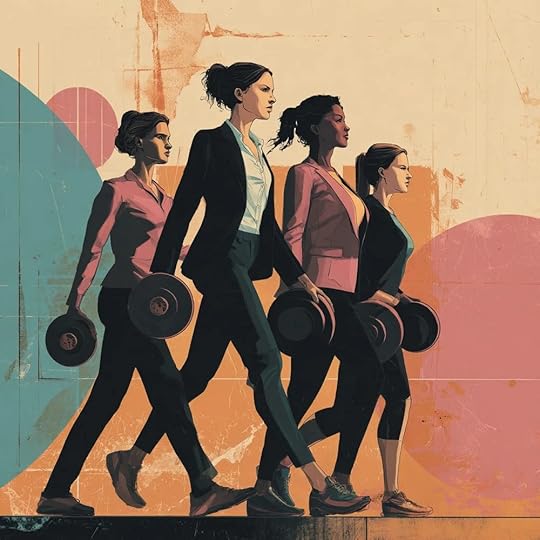 2. “Jobs” ≠ “Work” . Get fit for periods where we have work but not a full-time job.
2. “Jobs” ≠ “Work” . Get fit for periods where we have work but not a full-time job.Official payroll jobs are a narrow concept: a single employer, a W‑2, a slot in the BLS counts. Work is everything people do to create value, paid or not, whether it shows up on a company’s head‑count or not. Once you separate the two, the paradox becomes clearer:
We are at peak full-time jobs but not peak work or wealth creation opportunities.
The faster we delink work and jobs in our minds and the way companies are run the better off we will be.
Too many leaders fixate around jobs, classical organization design and place as critical when a new generation of companies focus on work to be done to deliver outcomes with different types of talent ( full time, freelance, fractional, contract and agentic) wherever they are to maximize agility and minimize costs. The age of conducting talent with a baton is cool for a classical age but is useless in a jazz age of improvisation.
Why payroll jobs can flatten or fall…
Automation & AI: Firms can keep revenue rising while head‑counts stay flat. U.S. job openings slid from 8.1 million in March 2024 to 7.2 million in March 2025 even though output kept growing. Bureau of Labor Statistics
Demographics: Retirements outpace new entrants in every rich economy; a smaller workforce limits the absolute number of jobs that can exist.
Risk off‑loading:Companies re‑label employees as contractors or outsource entire functions, removing positions from the payroll tally without killing the underlying tasks.
Capital‑first business models: Software, cloud services and robotics make it cheaper to buy capacity than hire people, so fewer traditional roles are created per dollar of GDP. Capital invests in “tireless” agents vs “tiresome” people.
While work opportunities can keep exploding (but often invisible to job statistics)
Gig & platform labor: At least 70 million Americans will freelance in 2025, on track to pass 86 million by 2027—meaning a majority of workers will earn income outside a W‑2 at least part‑time. Fortunly
The creator / micro‑entrepreneur economy: YouTube, TikTok, Substack and Shopify have spawned a $250 billion creator economy where millions earn revenue shares, sponsorships, or merch sales—none of which count as “employment.” Forbes
Solo & very‑small businesses: Record formation of 5.5 million new business applications in 2023 shows a surge of one‑person LLCs and side‑hustle ventures. These founders are working—sometimes 70 hours a week—but they don’t appear as employees. U.S. Chamber of Commerce
Unpaid but indispensable care work: Family caregivers now provide labor valued at ~$874 billion a year in the U.S.—bigger than the pharmaceutical industry—yet it is entirely off the payroll radar. Axios
Open‑source coding, online tutoring, volunteer crisis mapping, fan‑translation, DAO moderation—all productive, often time‑intensive work outside formal employment.
AI leverage: One skilled person plus copilots or low‑cost bots can do the output of a small team, so head‑counts shrink even as the task volume—and value—expands. Recently McKinsey reduced head count by 5,000 people while adding 12,000 agents.
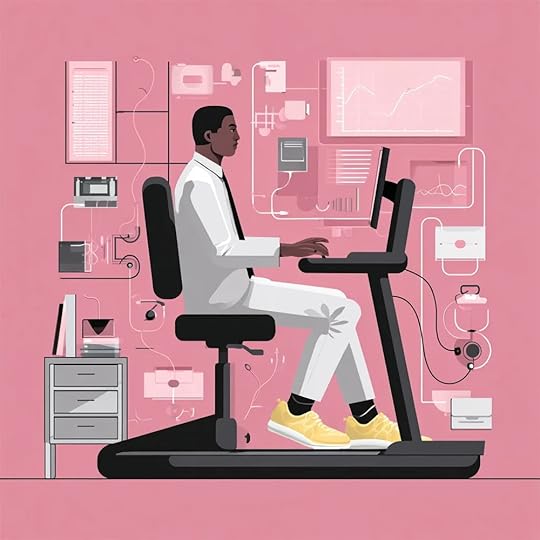 3. Sculpting a “Company of One” mindset is critical to keep a career fit.
3. Sculpting a “Company of One” mindset is critical to keep a career fit.Whether it is finding work post-retirement, working a side-hustle or passion project to make ends meet or build an expertise or create an off-ramp, or filling the gaps between full-time employment at firms which are often trigger-happy in adding and removing talent from their payrolls, the smart professional prepares to be a company of one.
But even if you do not fit any of these categories be aware that companies are creating internal marketplaces where opportunities can be identified and applied for and teams of experts can form and dissolve around projects.
As a result, for an individual to thrive in a company they will need to learn how to operate as a company of one. The combined power of the Avengers is because each of the Avengers is powerful on their own and not just because they learn to work as one.
Think of yourself as a better paid Uber driver with benefits if you work for a company.
If your expertise is needed at that time or in a particular market and location, and your collaboration and ability to work in teams is highly rated you will be in demand.
If not, as companies manage and monitor costs and increasingly find ways to plug into resources all the time everywhere you will find yourself parked permanently.
Or consider the Hollywood model where expertise come together on tv or movie projects and then the people disband and move on. Very few people work at a studio. Most people work in teams where they bring their skill whether it be casting, directing, catering or make up etc. The future of business will be similar as companies begin re-aggregating expertise around projects versus having hordes of generalists or people hanging around for a project. McKinsey and Bain have done this for years.
Nor everyone will be a freelancer going from gig to gig but if we build our career with the mindset of continually honing expertise, working well with other people in teams and being flexible, we will succeed in our company of tens of thousands versus thinking of ourselves as a cog in big machine waiting for someone to care for or build our career.
Think of our main as job as venture capital to fund the side gig or the next job.
We must plan for a very long career where work will involve both full time jobs and many other types of gigs and through it all we need to keep upgrading skills, reputation and collaborative skills by thinking of ourselves as a Company of One and never delegating our future to anyone else.
This allows us to be true to the only mantras worth following:
Keep skills up to tomorrow not just up to date .
Maximize Optionality.
All Images via MidJourney
October 12, 2025
On Education.
 The Power of Education.
The Power of Education.Three of the most powerful forces in the world are a) gravity b) compound interest and c) the bond between a mother and a child.
They have always existed driven by the power of science, math and nature.
An even more powerful force than these is education.
Education lifts us up while gravity holds us down.
Education compounds even more than compound interest in that it increases not just returns to money but returns to living.
Education is seen as crucial by mothers and fathers who invest and sacrifice for it.
 Education has never been more important.
Education has never been more important.Today in a world of change it is critical to upgrade our mental and emotional operating systems.
Transformation of lives and companies happen when talent transforms and the only way to do so is through education.
Education can be academic and in institutions and classrooms but a lot of education comes from the school of life, risk taking and experience.
While credentials may be important, education is less about degrees and more about learning new skills. It is about the building of new insights by connecting dots in new ways. The growth that comes from reflecting and building on failure and mistakes. The layers of experience that transform a body of knowledge into craft and expertise.
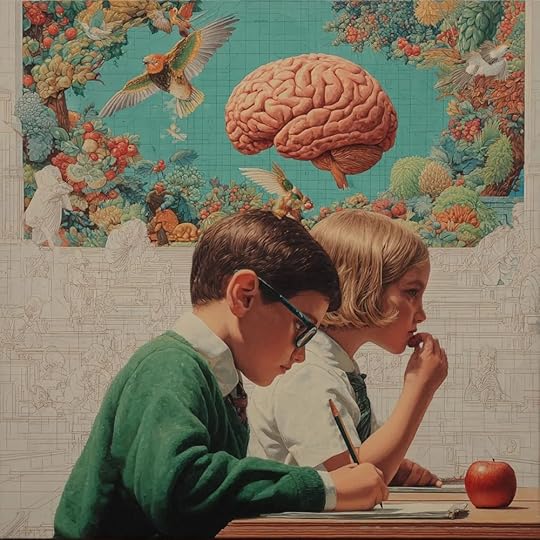 Education has never been easier.
Education has never been easier.While certain schools in countries continue to be highly expensive and deeply selective (often for no other reason than to constrain supply to allow graduates to earn high incomes) they are forgetting that education is about abundance versus scarcity. This mindset and way of teaching has now begun a rapid decline.
Today, a new world order and range of learning is increasingly available and will soon completely disrupt the old ways. Low cost resources from online courses, YouTube, AI tools and a series of credential courses from guilds and companies are making learning, training and skill development easier and easier. These skill sets can be monetized in a range of ways that does not require having credentials to get a job. World class tools including compute are available in the cloud on a just in time basis, AI agents to staff teams, and global marketplaces to access talent and inputs and sell services and products are a click away on the mobile device 24 hours a day.
The key is not to think of education as a signal to get us into a place but a way of building life long skills and learning that enables us to find meaningful, purposeful and rewarding work.
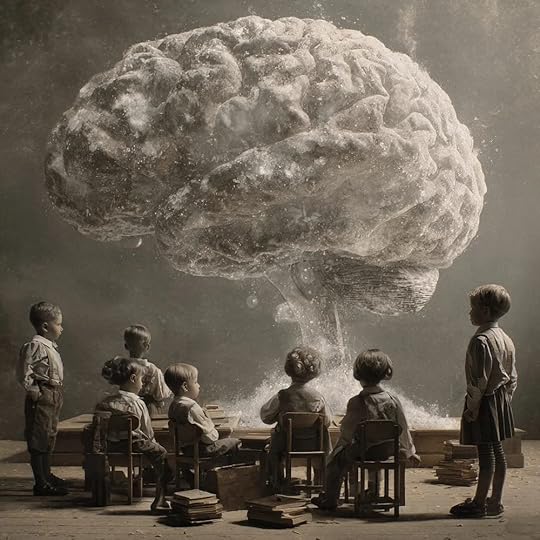 Education has never been more challenged.
Education has never been more challenged.Most professional education establishments are imparting irrelevant skills, concentrated in the first 25 years of life, using out of date approaches, for a job market that no longer exists.
Education in the traditional way is being deeply disrupted and the people in charge of learning are now going to have to go about unlearning their pedagogy!
The new educators will be a combination of reinvented outfits and self-educators, who enable and access new skills, across fifty year working careers, leveraging the latest methods and technologies , with a recognition that the majority of us will find meaningful purposeful work outside of jobs in a company.
The disparity between what is needed and where the future is going is a wide chasm.
 How to self-educate.
How to self-educate.Education is also not just about constant life-long learning but also unlearning.
The future does not fit in the mindsets of the past.
Five keys to self-educate when one has highly limited budgets and little to no time:
1. Set an hour a day to learn. This builds cognition which is the ability to think.
2. Build a case once in a while for the opposite of what you believe is true. This enables curiosity which is about asking what if? And why not?
3. Pay attention to what gives you flow and fit. This allows one to be creative which is best described as an expression of oneself.
4. Start with AI tools not search. Converse with other humans and machines. This will build skills of the choreographer allowing us to connect alien (eg. agentic AI ) and human life forms to drive outcomes.
5. Practice story telling in a multitude of forms from oral to visual to verbal. This will help us be communicators who can convince and move people.
Architecting, building, honing skills of cognition, creativity, curiosity, choreography and communication is the key to our future.
And educating ourselves in these is the best way to find purpose, meaning and rewards.
All images via prompts to MidJourney
Rishad Tobaccowala is a Company of One .
October 5, 2025
Rethinking …

The most popular edition of the 268 posts of this Substack so far is Rethinking Presentations on how to put together powerful presentations with only 9 slides!
The third most popular post is A Company of One on a way to ensure one remains relevant in a world of changing work.
This post combines a second approach to rethinking presentations and then illustrates how the format is used to get people to start rethinking work.
Rethinking Presentations 2Rethinking Presentations 1 showed how to put together a presentation to make a sale or get an order and remains a very impactful way to do so.
Over the past few years as I have worked for myself rather than a company. I spend less time selling and more time advising, explaining the tectonic shifts we are experiencing and trying to inspire new behavior. Here is a very simple approach anyone can use when one is trying to educate, explain or inspire change.
The three key outcomes this new format seeks to deliver are:
a) Accessible explanations that are simple, focused and identify all the key issues. People are overwhelmed.
b) Actionable inspiration that leaves people not just feeling inspired but armed with a way to take action right away.
c) Personalized relevance in that every single person finds relevance to their personal situation. It must resonate to help them solve a problem or take advantage of an opportunity.
This approach also requires only 9 key slides:
Slide 1: Title Slide (Action oriented)
Slide 2: Agenda (A simple, impactful way to telegraph what is to follow)
Slide 3: Shifts (What are the forces driving the changing situation and future)
Slide 4: Implications (What are the implications of these key shifts on the audience)
Slide 5: Realities (The hard truths and key challenges we need to face)
Slide 6: Approaches (What steps should one take right now)
Slide 7: Mindset (How to frame and address the situation moving forward)
Slide 8: Questions (Interaction and Q&A key when trying to explain/inspire)
Slide 9: Resources (Ways people can learn more and upgrade themselves)
Rethinking WorkThe Rethinking Work presentation below uses this 9 slide approach to explain to management why work will change more this decade than the previous 50 years and what leaders and companies need to understand and address right now.
But this same approach can be used by anybody who wants to educate, explain and inspire on any subject or topic. It is totally modular. Just change topic and put in the relevant shifts, implications, realities, exercises and mindsets!
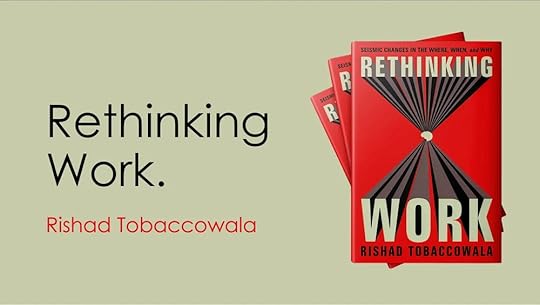
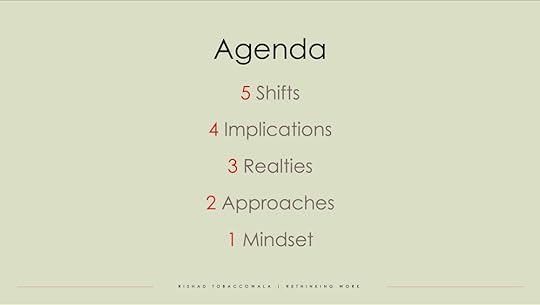
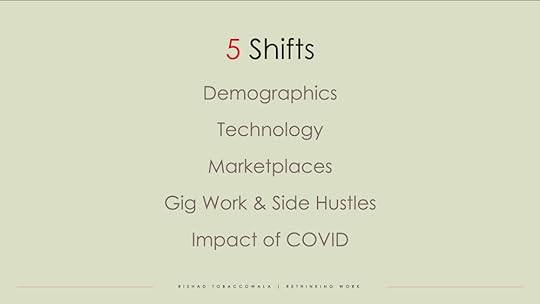 Five interconnected shifts will change work more this decade than the past 50 years.
Five interconnected shifts will change work more this decade than the past 50 years.Demographics of declining & aging population. Different mindsets across generations.
Technology (AI, Blockchain & Media Landscape where everyone is a media company).
Marketplaces that allow individuals and companies to access talent and opportunities.
More people will work part time or free-lance than full-time in the USA starting 2026.
Covid did not just change where we work but why we work and who we work for.
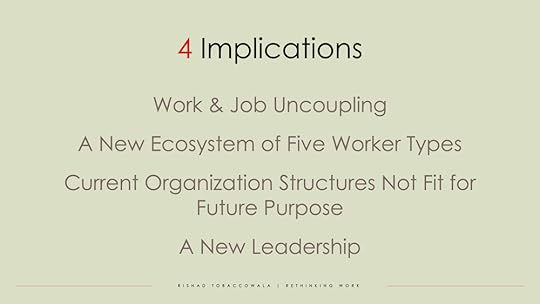 Four implications that organizations and leaders must address.
Four implications that organizations and leaders must address.More and more work will be done without filling jobs. Until 200 years ago there was lots of work and few jobs. We are now going to have more and more work and income/wealth opportunities than ever but fewer jobs. We are past peak jobs.
Full-time, freelance & contract employees will be joined by fractionalized employees and agentic workers.
Current structures of most companies are often built around jobs rather than how to get work done by attracting and retaining the best talent with the greatest agility and affordability.
Debossification is the only way forward where leaders focus on zones of influence vs zones of control. Where leaders spend the majority of their time selling, building, inspiring, servicing and mentoring vs. monitoring, measuring, processing, and checking in, all of which will be done better by AI.
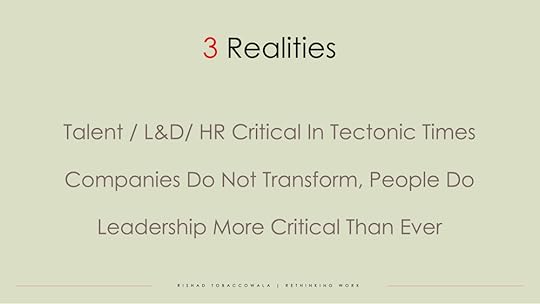 Three realities every company must face.
Three realities every company must face.Companies do not transform people do. Change never happens without a talent plan.
Talent/L&D more critical than ever but must reinvent themselves and be less fearful.
Leadership is the critical element more than technology or strategy or partnerships.
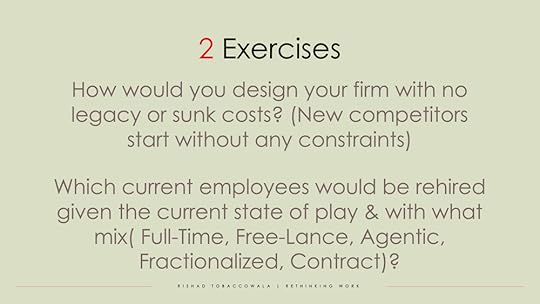 Two Exercises.
Two Exercises.Most management is world class but often self oppress and limit themselves by imagining constraints that only exist in their minds. These two exercises suggest starting with a fresh sheet on both the organizational and talent front.
Why is the current organizational structure which was probably out of date pre-Covid, pre-AI, pre-distributed work, still relevant for the tectonic changes coming? Without the right spinal architecture it makes no difference what AI or other organs are added.
The only thing a company has is talent. If the game changes and the playing field changes, talent needs to be rethought via a combination of upgrading skills, new ways of working and accessing of enhanced expertise both inside and outside the firm.
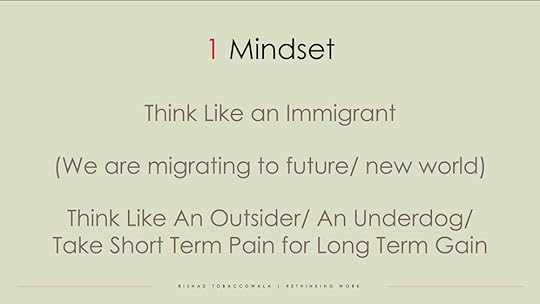 One Mindset.
One Mindset.We are all migrating to a new country, a new world, an unknown zone called the future which will not look like the place we are today.
So why have an immigrant mindset?
We need to think like outsiders since the new risks and opportunities will come from outside our existing competitive set.
We need to think like underdogs since AI is the slingshot that allows David to bring down Goliath. Moats might be used as sources of water to flood our castle!
We need to take the hard painful decisions and make the sacrifices now so we and our company can thrive in the future.
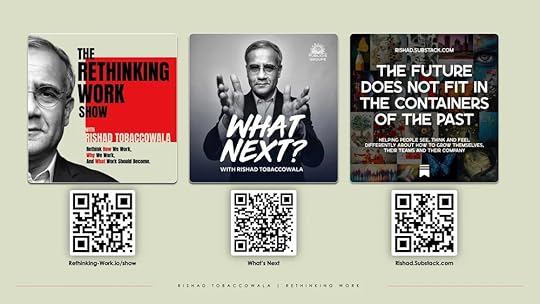 Questions and Resources to Keep Learning.
Questions and Resources to Keep Learning.Education, Learning and Reinventing are constant.
Here are three completely free resources to upgrade one’s mental operating system:
This Substack (The Future Does Not Fit in the Containers of the Past)
A weekly podcast (What Next?) where every week people who are forging the future share their best insights, provocations, perspectives and points of view.
And The Rethinking Work Show a show on YouTube but also on Spotify and Apple where every week a discussion with people reinventing work from CEO’s and architects wrestling with back to the office, technologists introducing agentic employees into the work place, academics with data that put a lie to so much fuzzy thinking about the future of work, pioneers designing new firms which are AI first, different generations speaking about companies and work and much more…
You can download the extended (18 slide version of this presentation which goes deeper into the 5 shifts and the 4 implications) here by clicking on the presentation and you may use it in anyway you want.
Also at Rethinking Work check out the resources section where there is career advice and lots of stuff to help every one become better and more effective. If you or someone you know is rethinking your career these four articles might completely change the way you plan the rest of your working life.



